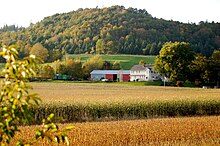Annapolis Valley
It is located in the western part of the Nova Scotia peninsula, formed by a trough between two parallel mountain ranges along the shore of the Bay of Fundy.
The steep face of basaltic North Mountain shelters the valley from the adjacent Bay of Fundy and rises over 260 metres (850 ft) in elevation near Lawrencetown.
New England Planters moved in to occupy the abandoned Acadian farming areas and the region also saw subsequent settlement by Loyalist refugees of the American Revolutionary War, as well as foreign Protestants.
The last quarter-century has also seen the development of a wine industry, with such notable wineries as Gaspereau Vineyards winning national and international awards for their produce.
Today, the Valley is still largely dominated by agriculture but also has a growing diversity in its economies, partly aided by the importance of post-secondary education centres provided by Acadia University in Wolfville, and the Nova Scotia Community College campuses located in Kentville, Middleton, Lawrencetown, and Digby.
Tourism is also an important industry and the Annapolis Valley is known for its scenic farmland, although today some is threatened with suburban development in the eastern end, and a great deal has been abandoned.
Farmers markets in Annapolis Royal, Bridgetown, Middleton, Kentville, Kingsport, Berwick and Wolfville bring a produce and other goods to the public every week.








